Abstract
In this study, femtosecond (FS) laser irradiation with different laser energy densities of 138, 276, and 414 mJ/cm2 is applied to SnO2-nanowire (NW) gas sensors, and the effect of the FS laser irradiation on the gas sensor response toward toluene (C7H8) gas is investigated. The FS laser irradiation causes oxygen deficiency in the SnO2 NWs and forms SnO and SnOx. Moreover, an embossing surface with multiple nano-sized bumps is created on the SnO2 NW surface because of the FS laser irradiation. The FS laser-irradiated SnO2-NW gas sensor exhibits superior sensing performance compared with the pristine SnO2-NW gas sensor. Moreover, the FS laser energy density significantly affects gas-sensing performance, and the highest sensor response is achieved by the gas sensor irradiated at 138 mJ/cm2. The long-term stability test of the laser-irradiated SnO2-NW gas sensor is performed by comparing fresh and 6-month-old gas sensors in different gas concentrations and relative humidity levels. Comparable gas-sensing behaviors are examined between the fresh and 6-month-old gas sensor, and this verifies the robustness of the laser-irradiated SnO2-NW gas sensor.
1. Introduction
Gas sensors have been widely used to protect the environment and human health as well as to control production quality in industrial applications [1,2]. Semiconducting metal oxide (SMO) gas sensors are one of the most widely used gas sensors because of their low cost, rapid response, and excellent sensitivity and stability [3]. Toluene (C7H8) is a well-known volatile organic compound (VOC) released from various household products such as flooring, furniture, and paintings. Therefore, we are repeatedly exposed to C7H8 environments, which can cause short- and long-term health risks, including throat, nose, and eye irritation, as well as liver and kidney cancers [4]. Therefore, to protect public health, the performance of SMO gas sensors should be further improved for an accurate and rapid examination of C7H8.
Various strategies have been investigated to improve the sensing capabilities of SMO gas sensors, including heterojunction formation [5,6], noble-metal functionalization [7], doping [8], surface engineering [9,10], and irradiation [11,12,13,14,15,16,17,18,19]. Surface engineering focuses on enlarging the surface area to improve the sensing performance via the formation of one-, two-, or three-dimensional nanomaterials or the generation of surface roughness on the surface of the sensing material [9,10]. Irradiation techniques, including gamma-ray irradiation [15], plasma treatment [12], ion implantation [16], electron-beam irradiation [13,14], and laser irradiation [17,20,21], are another approach for improving sensing performance. Applying external energy to sensing materials via irradiation induces structural defects (e.g., oxygen deficiency), and the associated non-stoichiometry contributes to increased interaction with gases. Therefore, non-stoichiometric metal oxides offer improved sensing performance [20]. Among the irradiation techniques, laser irradiation is promising owing to its ease of control, rapid and precise process, and no requirement for a clean room or vacuum chamber. Hou et al. [18] reported that pulsed laser irradiation improved the response of an Al-doped ZnO gas sensor toward H2 gas. Moreover, Zhang et al. [19] applied an excimer laser to a WO3 gas sensor and demonstrated improved performance toward NO2 gas.
Among the various SMO gas sensors, SnO2 is a promising sensing material owing to its excellent stability, high electron mobility, non-toxicity, and low synthesis cost [21]. The different morphologies of SnO2 include nanoneedles, nanofibers, films, nanoparticles, nanowires, and hollow spheres [22,23,24,25,26,27,28,29]. SnO2 nanowires have been widely adopted as a sensing material owing to their large surface areas, which enables more target gases to be absorbed, thus resulting in better sensing response [27,28,29]. However, the sensing performance should be enhanced to accurately examine the presence of C7H8.
In this study, the femtosecond (FS) laser is irradiated on the SnO2 NWs, and the effect on the gas-sensing behavior of the NWs is investigated. Different laser energy densities are applied to the SnO2 NWs, and the sensing behaviors of the pristine and laser-irradiated SnO2 NWs toward C7H8 are examined. The laser-irradiated SnO2 NWs perform better in terms of gas-sensing behavior compared with that of the pristine SnO2 NWs. Therefore, transmission electron microscopy (TEM) and electron energy loss spectroscopy (EELS) are performed to determine the changes in the surface morphology and chemical state of the SnO2 NWs after the FS laser irradiation. The FS laser irradiation increases the surface area and results in structural defects in the SnO2 NWs, which are characteristic of surface engineering and irradiation techniques. The results of this study verify that the ultrashort pulse laser irradiation is a promising approach for enhancing the sensing capability of SnO2 NWs.
2. Experimental
2.1. Synthesis of SnO2 NWs
An Au-catalyzed vapor–liquid–solid (VLS) technique was adopted for the SnO2 NWs’ growth. Details regarding the VLS technique are available in our previous paper [30]. A Si wafer with a SiO2 layer (thickness: 200 nm) was utilized as the substrate. Tri-layered electrodes comprising Ti (50 nm), Pt (200 nm), and Au (3 nm) were deposited onto the substrate via sputtering. A tri-layer-deposited substrate with metallic Sn powder (99.9%, Sigma-Aldrich, St. Louis, MO, USA) was placed in a quartz tube furnace. The furnace was heated up to 900 °C under a gas flow comprising N2 (300 sccm) and O2 (10 sccm). Thus, a SnO2 NW-based gas sensor device was fabricated. Figure 1 shows a field emission scanning electron microscopy (FE-SEM) image of a successfully grown network of SnO2 NWs on tri-layered electrodes.
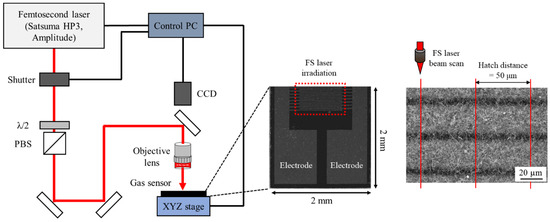
Figure 1.
Schematic diagrams of laser system, gas sensor electrode, and FS laser-irradiation procedure.
2.2. Femtosecond Laser Irradiation
The experimental setup for the FS laser irradiation is shown in Figure 1. An FS laser (Satsuma HP3, Amplitude Laser, Pessac, France) with a central wavelength of 1030 nm, pulse duration of 350 fs, and frequency of 15 kHz was applied to the gas sensor device. The laser beam quality (M2) was measured to be 1.2 in both the horizontal and vertical directions. The laser pulse energy was controlled using a half-wave plate and thin-film polarizing beam splitter (PBS) combined, and the laser beam was delivered by a beam mirror train. The laser beam was focused on the gas sensor device through a 10× infinity corrected microscope objective lens, thus resulting in a laser beam diameter of 4.8 μm. The laser beam scanning speed was set to 80 mm/s using a computer-controlled motion system (M-414, PI Benelux, Karlsruhe, Germany). The FS laser was irradiated on a network of SnO2 NWs (at the dotted red region in the gas sensor device, as shown in Figure 1) at a hatch distance of 50 μm. Fifteen linear laser-beam scans were performed. The applied laser pulse energies were 0.025, 0.05, and 0.075 μJ, which were equivalent to the laser fluences of 138, 276, and 414 mJ/cm2, respectively. The laser fluence was calculated as follows:
Laser fluence (mJ/cm2) = Laser pulse energy (mJ)/Laser beam area (cm2)
2.3. Characterization
A qualitative analysis of the SnO2 NWs was conducted via X-ray diffraction (XRD, X’Pert PRO, PANalytical, Malvern, UK) using Cu-Ka radiation (λ = 1.5418 Å). The morphology and microstructure of the SnO2 NWs was examined via FE-SEM (Hitachi S-4200, Tokyo, Japan) and transmission electron microscopy (TEM, Carl Zeiss LIBRA 200 MC, Jena, Germany). The fabricated SnO2 NWs were dispersed in isopropyl alcohol and deposited onto a Cu TEM grid (01890-F, Ted Pella, Inc., Redding, CA, USA) to prepare the TEM specimens. The electron energy loss spectroscopy (EELS) analysis was conducted to examine the chemical characteristics of the pristine and laser-irradiated SnO2 NWs. The first O peak in the EELS spectra (at approximately 532 eV) was used as a reference to align the EELS spectra of the pristine and laser-irradiated SnO2 NWs. Subsequently, peak analysis was conducted [31].
2.4. Gas-Sensing Measurements
A customized gas-sensing system was adopted to examine the gas-sensing behavior. A gas chamber was placed in a quartz tube furnace, and the operating temperature of the gas sensor was controlled. The concentration of the target gas (C7H8 gas in this study) was determined by mixing it with dry air, and the gas mixing ratio was controlled using mass-flow controllers. The mixture was flowed at 500 sccm.
The gas-sensing behavior was measured using a custom-developed gas-sensing system. The gas chamber was placed in a quartz tube furnace to control the operating temperature of the gas sensor. The target gas was mixed with dry air using mass-flow controllers to obtain its specific gas concentrations. The flow rate was maintained at 500 sccm. A Keithley source meter (Series 2400) was used to measure the electrical resistance during the sensing measurements in air (Ra) and target gas (Rg) atmospheres, and the sensor response was calculated as R = Rg/Ra. Moreover, the response time (τres) was measured at the time for the sensor to reach 90% of its final resistance value after supplying the target gas, whereas the recovery time (τres) was measured at the time for the sensor to reach 90% of its initial resistance value after the target gas supply was halted. To investigate the effect of humidity, we examined the sensing behavior at different relative humidity (RH) values. The long-term stability tests were conducted by comparing the fresh and 6-month-old gas sensors in various target gas concentrations and RH values.
3. Results and Discussions
3.1. Microstructures
Figure 2 shows the qualitative XRD analysis of the pristine SnO2 NWs (Figure 2a) and laser-irradiated SnO2 NWs with different laser energy densities of 138 (Figure 2b) and 414 (Figure 2c) mJ/cm2. For each specimen, the XRD patterns were consistent with those of crystalline SnO2 (tetragonal rutile structure, JCPDS File No. 88-0287 [32]), and no additional peaks were observed. Figure 3a,b shows the TEM images of the pristine SnO2 NW and laser-irradiated SnO2 NW with a laser energy density of 138 mJ/cm2, respectively. High-resolution TEM images and selected area electron diffraction (SAED) patterns are shown in red boxes. For the pristine SnO2 NW, a smooth and flat nanowire surface was observed. Moreover, both the d-spacing and SAED pattern analyses verified the tetragonal rutile structure of the SnO2 NWs [33]. For the laser-irradiated SnO2 NW, the equivalent crystal structure was analyzed based on the d-spacing and SAED pattern, which indicated no crystal structure change after the FS laser irradiation. However, multiple FS laser irradiation-induced nano-sized bumps developed on the nanowire surface (denoted by red arrows). This embossing surface may create more adsorption sites for gas species, thus improving sensing performance.
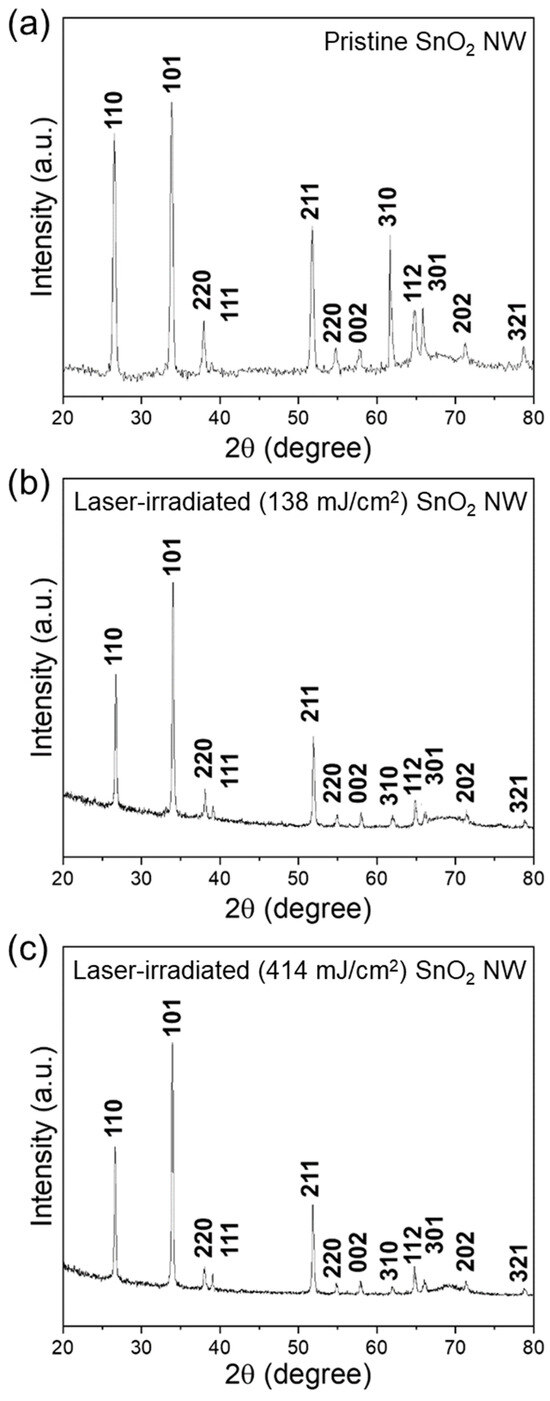
Figure 2.
XRD spectra for the (a) pristine SnO2 NW, (b) laser-irradiated SnO2 NW with a laser energy density of 138 mJ/cm2, and (c) laser-irradiated SnO2 NW with a laser energy density of 414 mJ/cm2.
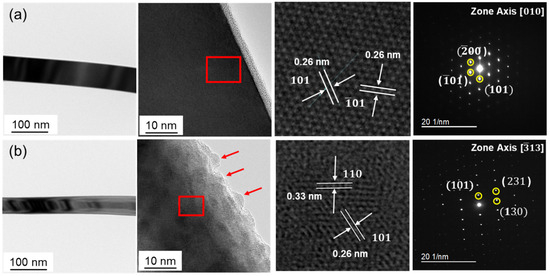
Figure 3.
TEM image, high-resolution TEM image, and SAED pattern of the (a) pristine SnO2 NW and (b) laser-irradiated SnO2 NW with a laser energy density of 138 mJ/cm2.
The EELS analysis was performed to determine the chemical states before and after the FS laser irradiation. Figure 4 shows the energy-loss spectra of the pristine SnO2 NWs and laser-irradiated SnO2 NWs with a laser energy density of 138 mJ/cm2. According to Moreno et al. [31], the EELS spectrum can be used to identify different Sn oxides (i.e., SnO2, SnO, and SnOx); thus, in this study, the EELS spectra before and after the FS laser irradiation were used to examine the chemical state of Sn oxides. For the pristine SnO2 NWs, the EELS spectrum was equivalent to that reported by Moreno et al. [31]. The O K-edge in the energy range of 527–545 eV comprised two peaks, and the peak separation was 5.82 eV. Moreover, the Sn M4,5 edges in the energy range of 490–505 eV and single distinct Sn M4 and M5 edges were examined at 495.83 and 501.26 eV, respectively. However, a slightly different EELS spectrum was observed for the laser-irradiated SnO2 NWs with respect to the peak shifts and generations. A relatively large peak separation (6.25 eV) was detected at the O K-edge, and multiple Sn M4,5 edges were observed at the Sn M edge. These modifications in the EELS spectrum contributed to the formation of SnO or SnOx phases after the FS laser irradiation. The SnO2 and SnO have different peak positions at the O K edge and Sn M4,5 edges [31]. Consequently, the presence of SnO or SnOx (developed from a combination of SnO2 and SnO) in SnO2 resulted in a slightly larger O K edge separation and multiple Sn M4,5 edges, thus indicating that the presence of different Sn oxides (i.e., SnO2, SnO, and SnOx) was caused by the FS laser irradiation.
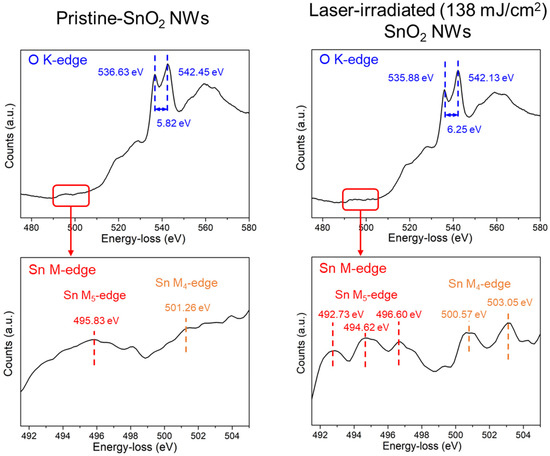
Figure 4.
EELS spectra of O K edge and Sn M4,5 edges for the pristine SnO2 NW and laser-irradiated SnO2 NW with a laser energy density of 138 mJ/cm2.
3.2. Gas-Sensing Studies
Figure 5a shows the transient resistance curves of the pristine gas sensor in the range of 50–350 °C for 10, 30, and 50 ppm of C7H8 gas, and the corresponding sensor response and base resistance are shown in Figure 5b. At 50 °C, no response was observed, whereas marginal resistance changes were indicated at 100 °C once the target gas supply was introduced and halted. The resistance decreased slightly as the target gas supply was introduced, which is characteristic of the gas-sensing behavior of n-type SMO gas sensors. As the temperature increases, more significant resistance changes and higher sensor responses were observed. Moreover, the optimum sensing performance was observed at 300 °C, where the sensor indicated a response level of 1.52 at 50 ppm of C7H8 gas. Meanwhile, the resistance change and sensor response observed at 350 °C were lower than those observed at 300 °C. No gas sensor response was indicated at low temperatures because the target gas molecules did not possess sufficient energy to overcome the adsorption barrier. At 300 °C, the desorption rate of the oxygen molecules and the absorption rate of the target molecules were equivalent, thus resulting in the optimum sensing performance. At 350 °C, the desorption rate exceeded the adsorption rate; therefore, a relatively weaker sensor response was achieved compared with that achieved at 300 °C. Thus, subsequent gas-sensing tests were performed at 300 °C.
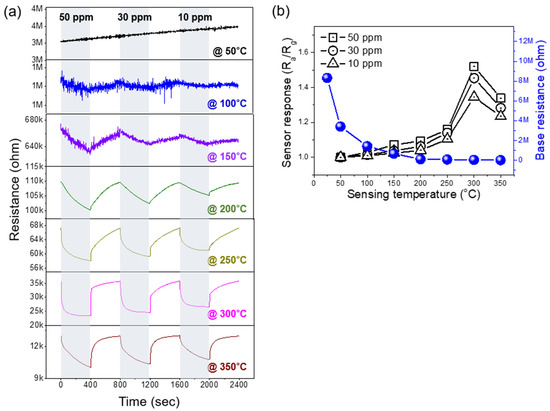
Figure 5.
(a) Dynamic resistance curves of the pristine SnO2 NWs for 10, 30, and 50 ppm of C7H8 gas at different sensing temperatures. (b) Corresponding sensor response and base resistance as a function of sensing temperature.
Figure 6a shows the dynamic resistance curves of the pristine SnO2 NWs and laser-irradiated SnO2 NWs with the laser energy densities of 138, 256, and 414 mJ/cm2 toward 10, 30, and 50 ppm of C7H8 gas. Figure 6b shows the corresponding sensor response and base resistance as a function of the laser energy density. The sensor response for the pristine SnO2 NWs was 1.52 at 50 ppm of C7H8 gas, whereas that for the laser-irradiated SnO2 NWs with a laser energy density of 138 mJ/cm2 was 2.42. The sensor response decreased as the laser energy density increased; interestingly, the sensor with higher base resistance values exhibited better sensor response toward C7H8 gas. Figure 6c shows the response and recovery times as a function of the laser energy density toward 50 ppm of C7H8 gas. The shortest response and recovery times were indicated by the laser-irradiated SnO2 NWs with a laser energy density of 138 mJ/cm2, which demonstrated the highest sensor response. This result verifies that the FS laser irradiation improves the gas-sensing performance, and laser parameters significantly affect the gas-sensing performance.
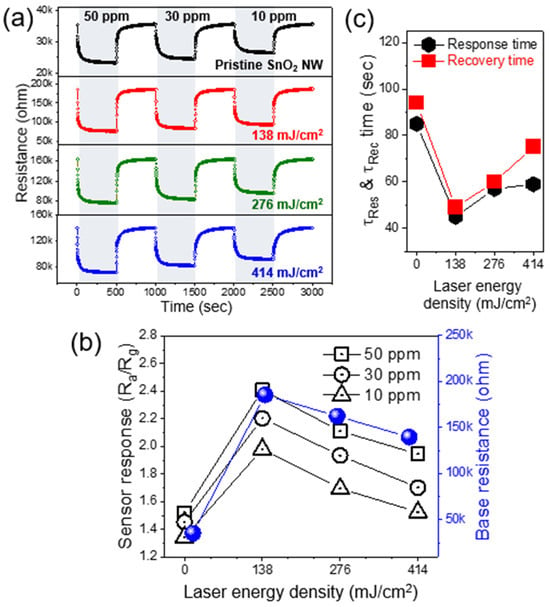
Figure 6.
(a) Dynamic resistance curves of the pristine and laser-irradiated SnO2 NWs (laser energy density: 138, 276, and 414 mJ/cm2) for 10, 30, and 50 ppm of C7H8 gas. (b) Corresponding sensor response and base resistance as a function of laser energy density. (c) Corresponding response and recovery times as a function of laser energy density toward 50 ppm of C7H8 gas.
Gas-sensing tests were conducted at different RH values to examine the reliability of the SnO2 gas sensor. Figure 7 shows the dynamic resistance curves and the corresponding sensor response and base resistance for the pristine SnO2 NWs (Figure 7a) and laser-irradiated SnO2 NWs with a laser energy density of 138 mJ/cm2 (Figure 7b) toward 10, 30, and 50 ppm of C7H8 gas. Both gas sensors showed deteriorated sensing performance as the RH level increased. This is because water molecules may adhere to the adsorption sites of the SnO2 NWs, where the target gas should be adsorbed, thus deteriorating the sensing performance as the RH level increases [34].
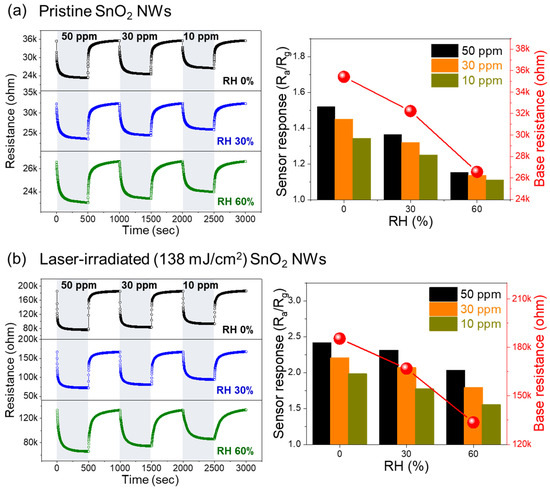
Figure 7.
Dynamic resistance curves and corresponding sensor responses and base resistances at different RH levels for the (a) pristine and (b) laser-irradiated SnO2 NWs with a laser energy density of 138 mJ/cm2.
3.3. Gas-Sensing Mechanism
Oxygen molecules are adsorbed on the sensing materials (i.e., SnO2 NWs) when the gas sensor is exposed to air, and the following reaction can occur because of the high electron affinity of oxygen [35,36]:
The adsorbed oxygen extracts electrons from the SnO2 NW surface. Consequently, an electron depletion layer (EDL) is developed at the subsurface, and electrons are confined at the core of the SnO2 NWs (known as the conduction volume or conduction channel). When a reducing target gas (C7H8 gas in this study) is supplied, the target gas adsorbs onto the SnO2 NW surface instead of onto oxygen. Therefore, the electrons extracted from the oxygen return to the SnO2 NWs, thus decreasing both the EDL width and sensor resistance. The relevant reactions are as follows [4,37]:
where, for toluene (C7H8) gas, “m” and “n” values are 7 and 8, respectively. value is equal to ; therefore, value becomes 18 and value is 1. As a result, the reaction is as follows:
Next, we analyzed the mechanism of the improved sensor response after the FS laser was irradiated on the SnO2 NWs. A higher initial sensor resistance facilitates better response by the chemosorbed gas sensor. This is because the sensor response is measured as Ra/Rg. For the laser-irradiated SnO2-NW gas sensors, two different factors, i.e., the embossing surface and oxygen deficiency, should be considered. First, the FS laser irradiation creates an embossing surface on the SnO2 NWs, as shown in the TEM image, which may increase the surface area of the SnO2 NWs. Therefore, a greater amount of oxygen is adsorbed onto the SnO2 NWs, thus increasing both the base resistance and gas response. Second, the FS laser irradiation results in oxygen deficiency in the SnO2 NWs by forming SnO and SnOx. This generates additional electron conduction, thus reducing both the base resistance and gas response. These two factors are conflicting; when the embossing surface effect is dominant, the sensor response is enhanced, whereas when the oxygen deficiency effect is dominant, the sensor response deteriorates. The sensor response was optimal at a laser energy density of 138 mJ/cm2 but decreased as the laser energy density increased. This may be because the embossing surface effect was optimized at 138 mJ/cm2, whereas the oxygen deficiency effect became more prominent as the laser energy density increased, which is attributed to a decrease in the sensor response. Figure 8 summarizes the sensing mechanism of the FS laser-irradiated gas sensor for C7H8 gas.
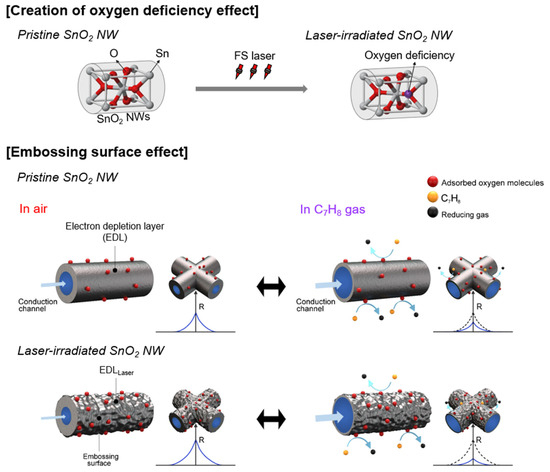
Figure 8.
Schematic diagram of sensing mechanism of the laser-irradiated SnO2 NWs in terms of oxygen vacancy and electron depletion.
3.4. Long-Term Stability Test
The fresh and 6-month-old SnO2 gas sensor were used to examine the long-term stability of a laser-irradiated SnO2-NW gas sensor. To the best knowledge of the authors, this is the first time the long-term stability of a laser-irradiated SnO2-NW gas sensor has been investigated. Figure 9 shows the dynamic resistance curves and the corresponding sensor response for the pristine SnO2 NWs (Figure 9a) and laser-irradiated SnO2 NWs with a laser energy density of 138 mJ/cm2 (Figure 9b) toward 0.6, 1, 10, 30, and 50 ppm of C7H8 gas. For the pristine and laser-irradiated SnO2 NWs, the fresh and 6-month-old gas sensors showed comparable gas sensor performance. It is worth noting that the laser-irradiated SnO2 NWs were able to sense 0.6 ppm of C7H8 gas with a sensor response of 1.06 and 1.07 for the fresh and 6-month-old sensors. On the contrary, no sensor response was examined at the C7H8 gas concentration of 0.6 ppm for the pristine SnO2 NWs. This result supports the notion that FS laser irradiation enhances gas sensor sensitivity.
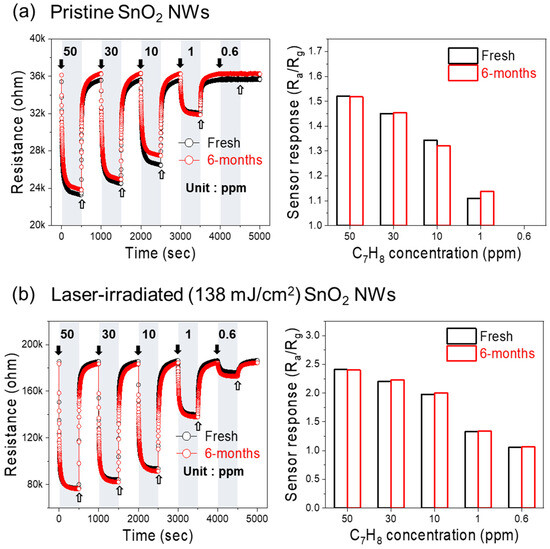
Figure 9.
Dynamic resistance curves and corresponding sensor responses at different C7H8 gas concentrations for the fresh and 6-month-old gas sensors of (a) pristine and (b) laser-irradiated SnO2 NWs with laser energy density of 138 mJ/cm2.
Figure 10 compares the gas-sensing behavior at different RH levels for the fresh and 6-month-old gas sensors of pristine SnO2 NWs and laser-irradiated SnO2 NWs with a laser energy density of 138 mJ/cm2. Figure 10a,b shows the normalized resistance curve and corresponding sensor response for the fresh and 6-month-old pristine SnO2 gas sensors, respectively. Moreover, Figure 10c,d presents the normalized resistance curve and corresponding sensor response for the fresh and 6-month-old laser-irradiated SnO2 gas sensors, respectively. The fresh and 6-month-old gas sensors show similar gas-sensing behaviors for both pristine and laser-irradiated SnO2 NWs. Comparable sensor response values were obtained at different RH levels for the fresh and 6-month-old gas sensors of pristine SnO2 NWs and laser-irradiated SnO2 NWs. The long-term stability tests in Figure 9 and Figure 10 indicate that no deterioration was detected in the sensing performance for both pristine and laser-irradiated SnO2 NWs, even after 6 months from the gas sensor’s fabrication. These results verify the robustness of laser-irradiated SnO2-NW gas sensors.
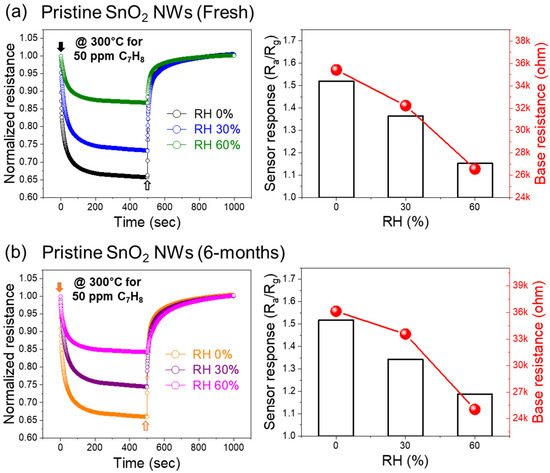
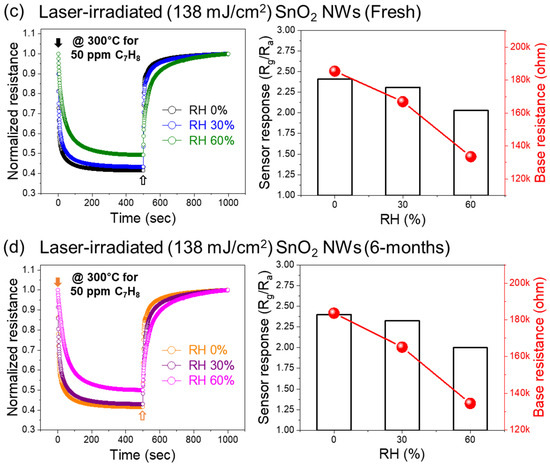
Figure 10.
Dynamic resistance curves and corresponding sensor responses at different RH levels for the (a) fresh and (b) 6-month-old gas sensors of the pristine SnO2 NWs and the (c) fresh and (d) 6-month-old gas sensors of the laser-irradiated SnO2 NWs with laser energy density of 138 mJ/cm2.
4. Conclusions
In this study, the SnO2 NWs were synthesized using the Au-catalyzed VLS method. Subsequently, the SnO2 NWs were irradiated with the FS laser at energy densities of 138, 276, and 414 mJ/cm2. Based on the results of the TEM analysis, the flat surface of the SnO2 NWs transformed into an embossing surface with multiple nano-sized bumps owing to the FS laser irradiation. Moreover, the result of EELS analysis revealed that the FS laser irradiation induced the formation of the SnO and SnOx phases in the SnO2 NWs. Subsequently, the gas-sensing behavior toward C7H8 gas as a reducing gas was examined. The gas-sensing performance of the FS laser-irradiated SnO2-NW gas sensor was superior to that of the pristine SnO2-NW gas sensor. Specifically, the FS laser-irradiated gas sensor with a laser energy density of 138 mJ/cm2 exhibited the highest gas response. The pristine SnO2 NWs showed a sensor response level of 1.52 at 50 ppm of C7H8 gas, whereas the laser-irradiated SnO2 NWs at 138 mJ/cm2 showed a sensor response level of 2.42. The sensing mechanism of the laser-irradiated gas sensor was attributed to the formation of an embossing surface and the generation of oxygen deficiency at the SnO2 NWs, which modulated the gas absorption sites and conduction channels, respectively. Moreover, the robustness of the laser-irradiated gas sensor was confirmed by verifying comparable gas-sensing behaviors between the fresh and 6-month-old gas sensors in different gas concentrations and RH levels.
Table 1 shows the sensitivity values of C7H8 gas with different SnO2-based sensing materials. Compared with other studies, the FS laser-irradiated SnO2 NWs showed a relatively low sensitivity value. However, those high sensitivity values were obtained with surface functionalization by using the heterojunction structure or catalytic effect. Different surface functionalization techniques or materials should be conducted to detect other target gases. Therefore, those approaches may have limited technological scalability. On the contrary, FS laser irradiation is a promising approach for enhancing the sensing performance toward multiple target gases because it is applicable to different types and shapes of SMOs.

Table 1.
Comparison of SnO2-based C7H8 gas sensing behavior.
Author Contributions
Conceptualization, C.P.; investigation, S.A.; data curation, S.A. and K.W.C.; writing—original draft preparation, S.A. and K.W.C.; writing—review and editing, C.P.; supervision, C.P. All authors have read and agreed to the published version of the manuscript.
Funding
This research was financially supported by the Seoul National University of Science and Technology.
Institutional Review Board Statement
Not applicable.
Informed Consent Statement
Not applicable.
Data Availability Statement
Dataset available on request from the authors.
Conflicts of Interest
The authors declare no conflict of interest.
References
- Timmer, B.; Olthuis, W.; van den Berg, A. Ammonia sensors and their applications—A review. Sens. Actuators B 2005, 107, 666–677. [Google Scholar] [CrossRef]
- Hübert, T.; Boon-Brett, L.; Black, G.; Banach, U. Hydrogen sensors—A review. Sens. Actuators B 2011, 157, 329–352. [Google Scholar] [CrossRef]
- Mirzaei, A.; Park, S.; Kheel, H.; Sun, G.-J.; Lee, S.; Lee, C. ZnO-capped nanorod gas sensors. Ceram. Int. 2016, 42, 6187–6197. [Google Scholar] [CrossRef]
- Mirzaei, A.; Kim, J.-H.; Kim, H.W.; Kim, S.S. Resistive-based gas sensors for detection of benzene, toluene and xylene (BTX) gases: A review. J. Mater. Chem. C 2018, 6, 4342–4370. [Google Scholar] [CrossRef]
- Kim, J.-H.; Lee, J.-H.; Mirzaei, A.; Kim, H.W.; Kim, S.S. Optimization and gas sensing mechanism of n-SnO2-p-Co3O4 composite nanofibers. Sens. Actuators B 2017, 248, 500–511. [Google Scholar] [CrossRef]
- Bang, J.H.; Choi, M.S.; Mirzaei, A.; Kwon, Y.J.; Kim, S.S.; Kim, T.W.; Kim, H.W. Selective NO2 sensor based on Bi2O3 branched SnO2 nanowires. Sens. Actuators B 2018, 274, 356–369. [Google Scholar] [CrossRef]
- Choi, S.-W.; Jung, S.-H.; Kim, S.S. Significant enhancement of the NO2 sensing capability in networked SnO2 nanowires by Au nanoparticles synthesized via γ-ray radiolysis. J. Hazard. Mater. 2011, 193, 243–248. [Google Scholar] [CrossRef] [PubMed]
- Kumar, V.; Sen, S.; Muthe, K.; Gaur, N.; Gupta, S.; Yakhmi, J. Copper doped SnO2 nanowires as highly sensitive H2S gas sensor. Sens. Actuators B 2009, 138, 587–590. [Google Scholar] [CrossRef]
- Hu, P.; Du, G.; Zhou, W.; Cui, J.; Lin, J.; Liu, H.; Liu, D.; Wang, J.; Chen, S. Enhancement of ethanol vapor sensing of TiO2 nanobelts by surface engineering. ACS Appl. Mater. Interfaces 2010, 2, 3263–3269. [Google Scholar] [CrossRef] [PubMed]
- Ma, Y.; Qu, Y.; Zhou, W. Surface engineering of one-dimensional tin oxide nanostructures for chemical sensors. Microchim. Acta 2013, 180, 1181–1200. [Google Scholar] [CrossRef]
- Kim, J.-H.; Mirzaei, A.; Kim, J.-Y.; Lee, J.-H.; Kim, H.W.; Hishita, S.; Kim, S.S. Enhancement of gas sensing by implantation of Sb-ions in SnO2 nanowires. Sens. Actuators B 2020, 304, 127307. [Google Scholar] [CrossRef]
- Pan, J.; Ganesan, R.; Shen, H.; Mathur, S. Plasma-modified SnO2 nanowires for enhanced gas sensing. J. Phys. Chem. C 2010, 114, 8245–8250. [Google Scholar] [CrossRef]
- Jiao, Z.; Wan, X.; Zhao, B.; Guo, H.; Liu, T.; Wu, M. Effects of electron beam irradiation on tin dioxide gas sensors. Bull. Mater. Sci. 2008, 31, 83–86. [Google Scholar] [CrossRef]
- Kim, J.-H.; Mirzaei, A.; Kim, H.W.; Wu, P.; Kim, S.S. Design of supersensitive and selective ZnO-nanofiber-based sensors for H2 gas sensing by electron-beam irradiation. Sens. Actuators B 2019, 293, 210–223. [Google Scholar] [CrossRef]
- Lavanya, N.; Sekar, C.; Anithaa, A.; Sudhan, N.; Asokan, K.; Bonavita, A.; Leonardi, S.; Neri, G. Investigations on the effect of gamma-ray irradiation on the gas sensing properties of SnO2 nanoparticles. Nanotechnology 2016, 27, 385502. [Google Scholar] [CrossRef] [PubMed]
- Kim, J.-H.; Kim, J.-Y.; Lee, J.-H.; Mirzaei, A.; Kim, H.W.; Hishita, S.; Kim, S.S. Indium-implantation-induced enhancement of gas sensing behaviors of SnO2 nanowires by the formation of homo-core–shell structure. Sens. Actuators B 2020, 321, 128475. [Google Scholar] [CrossRef]
- Assar, M.; Karimzadeh, R. Enhancement of methane gas sensing characteristics of graphene oxide sensor by heat treatment and laser irradiation. J. Colloid Interface Sci. 2016, 483, 275–280. [Google Scholar] [CrossRef]
- Hou, Y.; Jayatissa, A.H. Effect of laser irradiation on gas sensing properties of sol–gel derived nanocrystalline Al-doped ZnO thin films. Thin Solid Films 2014, 562, 585–591. [Google Scholar] [CrossRef]
- Zhang, C.; Van Overschelde, O.; Boudiba, A.; Snyders, R.; Olivier, M.-G.; Debliquy, M. Improvement of sensing characteristics of radio-frequency sputtered tungsten oxide films through surface modification by laser irradiation. Mater. Chem. Phys. 2012, 133, 588–591. [Google Scholar] [CrossRef]
- Al-Hashem, M.; Akbar, S.; Morris, P. Role of oxygen vacancies in nanostructured metal-oxide gas sensors: A review. Sens. Actuators B 2019, 301, 126845. [Google Scholar] [CrossRef]
- Das, S.; Jayaraman, V. SnO2: A comprehensive review on structures and gas sensors. Prog. Mater. Sci. 2014, 66, 112–255. [Google Scholar] [CrossRef]
- Tomer, V.K.; Devi, S.; Malik, R.; Nehra, S.P.; Duhan, S. Highly sensitive and selective volatile organic amine (VOA) sensors using mesoporous WO3–SnO2 nanohybrids. Sens. Actuators B Chem. 2016, 229, 321–330. [Google Scholar] [CrossRef]
- Ju, D.; Xu, H.; Xu, Q.; Gong, H.; Qiu, Z.; Guo, J.; Zhang, J.; Cao, B. High triethylamine-sensing properties of NiO/SnO2 hollow sphere P–N heterojunction sensors. Sens. Actuators B Chem. 2015, 215, 39–44. [Google Scholar] [CrossRef]
- Xu, Y.; Zheng, W.; Liu, X.; Zhang, L.; Zheng, L.; Yang, C.; Pinna, N.; Zhang, J. Platinum single atoms on tin oxide ultrathin films for extremely sensitive gas detection. Mater. Horiz. 2020, 7, 1519–1527. [Google Scholar] [CrossRef]
- Xu, H.; Li, W.; Han, R.; Zhai, T.; Yu, H.; Chen, Z.; Wu, X.; Wang, J.; Cao, B. Enhanced triethylamine sensing properties by fabricating Au@SnO2/α-Fe2O3 core-shell nanoneedles directly on alumina tubes. Sens. Actuators B Chem. 2018, 262, 70–78. [Google Scholar] [CrossRef]
- Qiao, X.-Q.; Zhang, Z.-W.; Hou, D.-F.; Li, D.-S.; Liu, Y.; Lan, Y.-Q.; Zhang, J.; Feng, P.; Bu, X. Tunable MoS2/SnO2 P–N heterojunctions for an efficient trimethylamine gas sensor and 4-nitrophenol reduction catalyst. ACS Sustain. Chem. Eng. 2018, 6, 12375–12384. [Google Scholar] [CrossRef]
- Tonezzer, M. Selective gas sensor based on one single SnO2 nanowire. Sens. Actuators B 2019, 288, 53–59. [Google Scholar] [CrossRef]
- Wang, B.; Zhu, L.F.; Yang, Y.H.; Xu, N.S.; Yang, G.W. Fabrication of a SnO2 nanowire gas sensor and sensor performance for hydrogen. J. Phys. Chem. C 2008, 112, 6643–6647. [Google Scholar] [CrossRef]
- Kuang, Q.; Lao, C.; Wang, Z.L.; Xie, Z.; Zheng, L. High-sensitivity humidity sensor based on a single SnO2 nanowire. J. Am. Chem. Soc. 2007, 129, 6070–6071. [Google Scholar] [CrossRef] [PubMed]
- Kim, J.-H.; Park, H.; Mirzaei, A.; Hahm, M.G.; Ahn, S.; Halik, M.; Park, C.; Kim, S.S. How femtosecond laser irradiation can affect the gas sensing behavior of SnO2 nanowires toward reducing and oxidizing gases. Sens. Actuators B Chem. 2021, 342, 130036. [Google Scholar] [CrossRef]
- Moreno, M.S.; Egerton, R.F.; Midgley, P.A. Differentiation of tin oxides using electron energy-loss spectroscopy. Phys. Rev. B 2004, 69, 233304. [Google Scholar] [CrossRef]
- Jayababu, N.; Poloju, M.; Shruthi, J.; Reddy, M.R. Semi shield driven p-n heterostructures and their role in enhancing the room temperature ethanol gas sensing performance of NiO/SnO2 nanocomposites. Ceram. Int. 2019, 45, 15134–15142. [Google Scholar] [CrossRef]
- Wei, Y.; Zheng, H.; Hu, S.; Pu, S.; Peng, H.; Li, L.; Sheng, H.; Zhou, S.; Wang, J.; Jia, S. Controllable synthesis of single-crystal SnO2 nanowires and tri-crystal SnO2 nanobelts. CrystEngComm 2018, 20, 7114–7119. [Google Scholar] [CrossRef]
- Kim, J.-H.; Mirzaei, A.; Kim, H.W.; Kim, S.S. Realization of Au-decorated WS2 nanosheets as low power-consumption and selective gas sensors. Sens. Actuators B 2019, 296, 126659. [Google Scholar] [CrossRef]
- Jian, Y.; Hu, W.; Zhao, Z.; Cheng, P.; Haick, H.; Yao, M.; Wu, W. Gas sensors based on chemi-resistive hybrid functional nanomaterials. Nano-Micro Lett. 2020, 12, 71. [Google Scholar] [CrossRef] [PubMed]
- Gawali, S.R.; Patil, V.L.; Deonikar, V.G.; Patil, S.S.; Patil, D.R.; Patil, P.S.; Pant, J. Ce doped NiO nanoparticles as selective NO2 gas sensor. J. Phys. Chem. Solids 2018, 114, 28–35. [Google Scholar] [CrossRef]
- Hermawan, A.; Asakura, Y.; Inada, M.; Yin, S. One-step synthesis of micro-/mesoporous SnO2 spheres by solvothermal method for toluene gas sensor. Ceram. Int. 2019, 45, 15435–15444. [Google Scholar] [CrossRef]
- Qiao, L.; Bing, Y.; Wang, Y.; Yu, S.; Liang, Z.; Zeng, Y. Enhanced toluene sensing performances of Pd-loaded SnO2 cubic nanocages with porous nanoparticle-assembled shells. Sens. Actuators B 2017, 241, 1121–1129. [Google Scholar] [CrossRef]
- Kim, J.H.; Kim, S.S. Realization of ppb-Scale Toluene-Sensing Abilities with Pt-Functionalized SnO2–ZnO Core–Shell Nanowires. ACS Appl. Mater. Interfaces 2015, 7, 17199–17208. [Google Scholar] [CrossRef] [PubMed]
- Hermawan, A.; Asakura, Y.; Inada, M.; Yin, S. A facile method for preparation of uniformly decorated-spherical SnO2 by CuO nanoparticles for highly responsive toluene detection at high temperature. J. Mater. Sci. Technol. 2020, 51, 119–129. [Google Scholar] [CrossRef]
- Liu, L.; Zhang, Y.; Wang, G.; Li, S.; Wang, L.; Han, Y.; Jiang, X.; Wei, A. High toluene sensing properties of NiO–SnO2 composite nanofiber sensors operating at 330 °C. Sens. Actuators B 2011, 160, 448–454. [Google Scholar] [CrossRef]
- Lee, J.; Min, H.; Choe, Y.-S.; Lee, Y.G.; Kim, K.; Lee, H.-S.; Lee, W. Highly sensitive and selective detection of benzene, toluene, xylene, and formaldehyde using Au-coated SnO2 nanorod arrays for indoor air quality monitoring. Sens. Actuators B 2023, 394, 134359. [Google Scholar] [CrossRef]
- Tian, J.; Wang, J.; Hao, Y.; Du, H.; Li, X. Toluene sensing properties of porous Pd-loaded flower-like SnO2 microspheres. Sens. Actuators B 2014, 202, 795–802. [Google Scholar] [CrossRef]
Disclaimer/Publisher’s Note: The statements, opinions and data contained in all publications are solely those of the individual author(s) and contributor(s) and not of MDPI and/or the editor(s). MDPI and/or the editor(s) disclaim responsibility for any injury to people or property resulting from any ideas, methods, instructions or products referred to in the content. |
© 2024 by the authors. Licensee MDPI, Basel, Switzerland. This article is an open access article distributed under the terms and conditions of the Creative Commons Attribution (CC BY) license (https://creativecommons.org/licenses/by/4.0/).